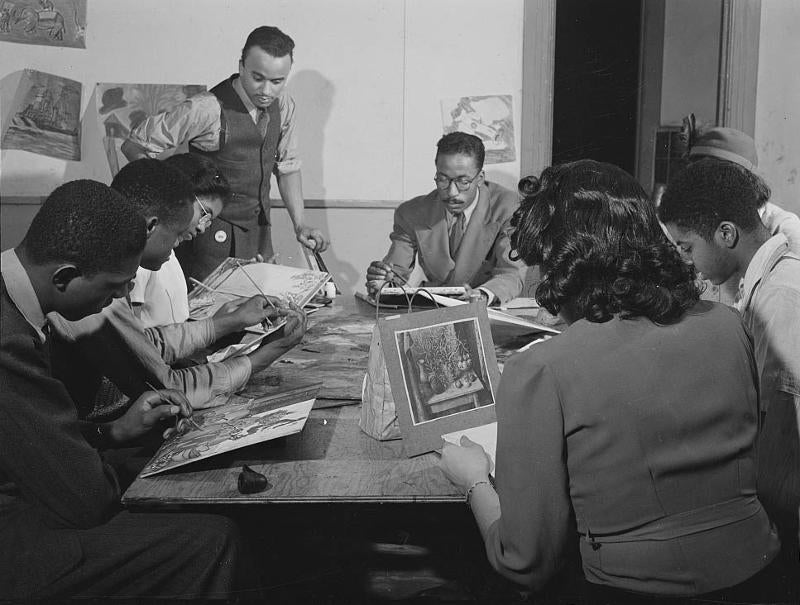A Reflection on the Course “Race, Representation, and Renaissance”
Meet Professor Amani Morrison

The Humanities: Arts, Literature, and Culture (HALC) Core requirement introduces students to the methods of the cultural humanities and arts. Individual faculty shape their courses to meet the learning goals for HALC articulated by a committee of faculty and students. In this ongoing series spotlighting faculty teaching and student learning in HALC, Professor Amani Morrison, Assistant Professor of African American Literature and Culture in Georgetown’s English Department, shares her reflections on designing and teaching her ENGL-210: Race, Representation, and Renaissance course as HALC.
“Race, Representation, and Renaissance” is a course that I designed and taught prior to my arrival to Georgetown last year but that naturally fit into the interdisciplinary aims of Georgetown’s HALC designation. In the course we engage poetry, fiction, essays, film, music, and visual culture, all while deeply exploring the historical and cultural contexts of the artists and their works. It is one of my favorite courses to teach, in part because it grew out of my own desire as first an undergraduate and then a graduate student to take a course focused on the Harlem Renaissance and, later, the Black Chicago Renaissance periods. Despite my American Studies undergraduate major and African American Studies masters and doctoral degrees, I had not had the opportunity to focus in-depth on those rich periods of cultural production in my coursework. My desire as a faculty member is to expand the range and depth of the university’s intellectual offerings in a way that honors the vast historical, intellectual, and cultural inquiry, creativity, and contributions of Black people in the United States. This course allows me to do that.
When I taught the course in Fall 2020, I recognized that we had just marked a century since the start of the New Negro Renaissance period. There were other notable intersections: we were living through a once-in-a-century pandemic, as people had in 1918; and, we were in a period of national racial reckoning, as the country had been with the Red Summer race riots of 1919. In class, we leaned into these resonances: alongside studying the blues tradition, students wrote their own blues poems about some aspect of 2020 that they felt could best be expressed through blues thematics. The results were remarkable as students challenged themselves to capture and express the depths of their emotions around pandemic isolation, a struggling economy, racial justice, environmental justice, loss, virtual learning, and the mundane joy and pain in everyday life through the rhythmic constraints of the blues. Moreover, students were tasked with analyzing their own poems to detail how, in fact, they were making use of the generic and thematic elements of the blues, and how they were gradually building meaning and message as their poems progressed to a close. If I’d had more capacity myself during that semester, I would have loved to engage the broader community in a similar work of writing and submitting a blues for 2020–I’m certain it would have been both illuminating and cathartic for many. I look forward to opportunities in future iterations of the course to potentially expand that form of engagement beyond the classroom.
A change I made to the course when I taught it for the HALC requirement and in the thick of the pandemic was to allow the students to tackle the assignment with the heaviest weight, creating a mini WordPress site, as a collaborative effort throughout the semester; the project was due well before the finals period, and I opted instead for a lower-stakes independent assignment as a final. This allowed for students to gradually develop and craft proposals for their projects, receive feedback, ask questions, polish their ideas and analyses, delegate and distribute work, and also complete self- and peer evaluations on how they contributed to the group effort. Students were able to cultivate WordPress proficiencies as well as some curatorial chops in their work as they engaged digital archival materials and employed close reading analytical skills.
“Race, Representation, and Renaissance” equips students to approach their further studies with interdisciplinarity and multiple audiences in mind, enables them to appreciate the resonances of the past within the present, and encourages their continued exploration (during and beyond their time at Georgetown) of archives, film, photography, and music alongside poetry and prose. The skills and perspective gained in this course undergird other, more advanced courses of mine, such as “Black Home Spaces in the U.S.” and a course-in-development, “Literature and the Archive,” and they also inform my scholarly research endeavors. The course was a pleasure to teach, as it always has been for me, and I enjoy each opportunity I have to introduce students to, and expand their engagement with, the cultural production, debates, history, and spirit of Black creative and intellectual life.
